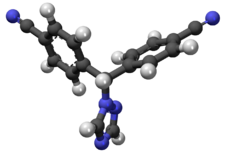Chemistry:Letrozole
 | |
 | |
| Clinical data | |
|---|---|
| Trade names | Femara, others |
| AHFS/Drugs.com | Monograph |
| MedlinePlus | a698004 |
| License data | |
| Routes of administration | By mouth |
| Drug class | Aromatase inhibitor; Antiestrogen |
| ATC code | |
| Legal status | |
| Legal status |
|
| Pharmacokinetic data | |
| Bioavailability | 99.9% |
| Protein binding | 60%, mainly to albumin |
| Metabolism | pharmacologically-inactive metabolites Bis(4-cyanophenyl)methanol and 4,4'-dicyanobenzophenone.[3] |
| Elimination half-life | 2 days[3] |
| Excretion | Kidney[3] |
| Identifiers | |
| |
| CAS Number | |
| PubChem CID | |
| IUPHAR/BPS | |
| DrugBank | |
| ChemSpider | |
| UNII | |
| KEGG | |
| ChEBI | |
| ChEMBL | |
| Chemical and physical data | |
| Formula | C17H11N5 |
| Molar mass | 285.310 g·mol−1 |
| 3D model (JSmol) | |
| |
| |
| (verify) | |
Letrozole, sold under the brand name Femara among others, is an aromatase inhibitor medication that is used in the treatment of breast cancer.[1]
It was patented in 1986 and approved for medical use in 1996.[4] In 2020, it was the 257th most commonly prescribed medication in the United States, with more than 1 million prescriptions.[5][6] It is on the World Health Organization's List of Essential Medicines.[7]
Medical uses
Breast cancer
Letrozole is approved by the United States Food and Drug Administration (FDA) for the treatment of local or metastatic breast cancer that is hormone receptor positive or has an unknown receptor status in postmenopausal women.[8]
Comparison with tamoxifen
Tamoxifen is also used to treat hormonally-responsive breast cancer, but it does so by interfering with the estrogen receptor. However, letrozole is effective only in post-menopausal women, in whom estrogen is produced predominantly in peripheral tissues (i.e. in adipose tissue, like that of the breast) and a number of sites in the brain.[9] In pre-menopausal women, the main source of estrogen is from the ovaries not the peripheral tissues, and letrozole is ineffective.
In the BIG 1–98 Study, of post-menopausal women with hormonally-responsive breast cancer, letrozole reduced the recurrence of cancer, but did not change survival rate, compared to tamoxifen.[10][11]
Ovulation induction
Letrozole has been used for ovulation induction by fertility doctors since 2001, because it has fewer side-effects than clomiphene (Clomid) and less chance of multiple gestation.[citation needed] A study of 150 babies following treatment with either letrozole alone or letrozole and gonadotropins presented at the American Society of Reproductive Medicine 2005 Conference found no difference in overall abnormalities but did find a significantly higher rate of locomotor and cardiac abnormalities among the group having taken letrozole compared to natural conception.[12] A larger, follow-up study with 911 babies compared those born following treatment with letrozole to those born following treatment with clomiphene.[13] That study also found no significant difference in the rate of overall abnormalities, but found that congenital cardiac anomalies was significantly higher in the clomiphene group compared to the letrozole group. Despite this, India banned the usage of letrozole in 2011, citing potential risks to infants.[14] In 2012, an Indian parliamentary committee said that the drug controller office colluded with letrozole's makers to approve the drug for infertility in India and also stated that letrozole's use for infertility was illegal worldwide;[15] however, such off-label uses are legal in many countries such as the US and UK.[16][17]
Contraindications
Letrozole is contraindicated in women having a pre-menopausal hormonal status, during pregnancy and lactation.[18]
Side effects
The most common side effects are sweating, hot flushes, arthralgia (joint pain), and fatigue.[18]
Generally, side effects include signs and symptoms of hypoestrogenism. There is concern that long term use may lead to osteoporosis,[8] which is why in certain patient populations such as post-menopausal women or osteoporotics, bisphosphonates may also be prescribed.[citation needed]
Interactions
Letrozole inhibits the liver enzyme CYP2A6, and to a lesser extent CYP2C19, in vitro, but no relevant interactions with drugs like cimetidine and warfarin have been observed.[18]
Pharmacology
Pharmacodynamics
Letrozole is an orally active, nonsteroidal, selective aromatase inhibitor and hence an antiestrogen. It prevents aromatase from producing estrogens by competitive, reversible binding to the heme of its cytochrome P450 unit. The action is specific, and letrozole does not reduce production of corticosteroids.[citation needed]
Research
The antiestrogen action of letrozole has been shown to be useful in pretreatment for termination of pregnancy, in combination with misoprostol. It can be used in place of mifepristone, which is expensive and unavailable in many countries.[19]
Letrozole is sometimes used as a treatment for gynecomastia, although it is probably most effective at this if caught in an early stage (such as in users of anabolic steroids).[20][21][unreliable source?]
Some studies have shown that letrozole can be used to promote spermatogenesis in male patients with nonobstructive azoospermia.[22]
Letrozole has also been shown to delay the fusing of the growth plates in mice.[23] When used in combination with growth hormone, letrozole has been shown effective in one adolescent boy with a short stature.[24]
Letrozole has also been used to treat endometriosis.[25]
Endometrial stromal sarcomas are hormonally sensitive tumors as it is represented that letrozole reduces serum estrogen levels. Letrozole is well-tolerated and is a good option for long-term management of this disease.[26] Also in a study on Uterine myoma the volume was successfully reduced by use of an aromatase inhibitor. Rapid onset of action and avoidance of initial gonadotropin flare with an aromatase inhibitor.[25]
Letrozole has been documented to be safe and effective for improving height and pubertal outcomes in children living with constitutional delay in growth and puberty, and is better than testosterone with regard to improvement in testicular volume and delaying bone-age progression. This was documented in a meta-analysis published by Dutta et al. which analyzed data from 7 different randomized controlled trials.[27]
References
- ↑ Jump up to: 1.0 1.1 "Femara- letrozole tablet, film coated". 13 May 2022. https://dailymed.nlm.nih.gov/dailymed/drugInfo.cfm?setid=82b77d74-085f-45ac-a7dd-1f5c038bf406.
- ↑ "List of nationally authorised medicinal products : Active substance(s): letrozole : Procedure No. PSUSA/00001842/202110". https://www.ema.europa.eu/documents/psusa/letrozole-list-nationally-authorised-medicinal-products-psusa/00001842/202110_en.pdf.
- ↑ Jump up to: 3.0 3.1 3.2 "Letrozole". 24 January 2003. http://www.orgyn.com/resources/genrx/D003330.asp.
- ↑ Analogue-based Drug Discovery. John Wiley & Sons. 2006. p. 516. ISBN 9783527607495. https://books.google.com/books?id=FjKfqkaKkAAC&pg=PA516.
- ↑ "The Top 300 of 2020". https://clincalc.com/DrugStats/Top300Drugs.aspx.
- ↑ "Letrozole - Drug Usage Statistics". https://clincalc.com/DrugStats/Drugs/Letrozole.
- ↑ The selection and use of essential medicines 2023: web annex A: World Health Organization model list of essential medicines: 23rd list (2023). Geneva: World Health Organization. 2023. WHO/MHP/HPS/EML/2023.02.
- ↑ Jump up to: 8.0 8.1 Drugs.com: Monograph for letrozole. It is also used for ovarian cancer patients after they have completed chemotherapy.
- ↑ "Sources of estrogen and their importance". The Journal of Steroid Biochemistry and Molecular Biology 86 (3–5): 225–30. September 2003. doi:10.1016/S0960-0760(03)00360-1. PMID 14623515.
- ↑ "Assessment of letrozole and tamoxifen alone and in sequence for postmenopausal women with steroid hormone receptor-positive breast cancer: the BIG 1-98 randomised clinical trial at 8·1 years median follow-up". The Lancet. Oncology 12 (12): 1101–8. November 2011. doi:10.1016/S1470-2045(11)70270-4. PMID 22018631.
- ↑ "32nd Annual San Antonio Breast Cancer Symposium". http://www.sabcs.org/EnduringMaterials/Index.asp.
- ↑ "The Outcome of 150 Babies Following the Treatment With Letrozole or Letrozole and Gonadotropins". Fertility and Sterility 84: S95. 2005. doi:10.1016/j.fertnstert.2005.07.230.
- ↑ "Congenital malformations among 911 newborns conceived after infertility treatment with letrozole or clomiphene citrate". Fertility and Sterility 85 (6): 1761–5. June 2006. doi:10.1016/j.fertnstert.2006.03.014. PMID 16650422.
- ↑ "Finally, expert panel bans fertility drug Letrozole". The Times of India. 18 October 2011. http://articles.timesofindia.indiatimes.com/2011-10-18/india/30296687_1_letrozole-breast-cancer-post-menopausal-women.
- ↑ "House panel to govt: Punish those guilty of approving Letrozole". The Times of India. 10 April 2007. http://articles.timesofindia.indiatimes.com/2012-05-09/india/31641343_1_letrozole-anti-cancer-drug-infertility.
- ↑ "U.S. physician knowledge of the FDA-approved indications and evidence base for commonly prescribed drugs: results of a national survey". Pharmacoepidemiology and Drug Safety 18 (11): 1094–100. November 2009. doi:10.1002/pds.1825. PMID 19697444.
- ↑ "GMC | Good practice in prescribing medicines – guidance for doctors". Gmc-uk.org. 16 February 2007. http://www.gmc-uk.org/guidance/current/library/prescriptions_faqs.asp#5d.
- ↑ Jump up to: 18.0 18.1 18.2 (in de) Austria-Codex (2009/2010 ed.). Vienna: Österreichischer Apothekerverlag. 2009. ISBN 978-3-85200-196-8.
- ↑ "Misoprostol with or without letrozole pretreatment for termination of pregnancy: a randomized controlled trial". Obstetrics and Gynecology 117 (2 Pt 1): 317–23. February 2011. doi:10.1097/AOG.0b013e3182073fbf. PMID 21252745.
- ↑ "History of aromatase: saga of an important biological mediator and therapeutic target". Endocrine Reviews 30 (4): 343–75. June 2009. doi:10.1210/er.2008-0016. PMID 19389994.
- ↑ "Gynecomastia and Letrozole". GYNECOMASTIA-GYNO.COM. 16 December 2008. http://www.gynecomastia-gyno.com/gynecomastia-letrozole-treatment/.
- ↑ "Use of the aromatase inhibitor letrozole to treat male infertility". Fertility and Sterility 92 (2): 829.e1–2. August 2009. doi:10.1016/j.fertnstert.2009.05.014. PMID 19524225.
- ↑ "The aromatase inhibitor letrozole increases epiphyseal growth plate height and tibial length in peripubertal male mice". The Journal of Endocrinology 182 (1): 165–72. July 2004. doi:10.1677/joe.0.1820165. PMID 15225141.
- ↑ "Letrozole significantly improves growth potential in a pubertal boy with growth hormone deficiency". Pediatrics 115 (2): e245-8. February 2005. doi:10.1542/peds.2004-1536. PMID 15653791. http://pediatrics.aappublications.org/cgi/content/full/115/2/e245.
- ↑ Jump up to: 25.0 25.1 "The emerging use of aromatase inhibitors for endometriosis treatment". Reproductive Biology and Endocrinology 9: 87. June 2011. doi:10.1186/1477-7827-9-87. PMID 21693036.
- ↑ "Treatment of recurrent endometrial stromal sarcoma with letrozole: a case report and literature review". Hormones & Cancer 1 (2): 112–5. April 2010. doi:10.1007/s12672-010-0007-9. PMID 21761354.
- ↑ "Efficacy and Safety of Letrozole in the Management of Constitutional Delay in Growth and Puberty: A Systematic Review and Meta-analysis.". J Clin Res Pediatr Endocrinol. 14 (2): 131–144. September 2021. doi:10.4274/jcrpe.galenos.2021.2021.0169. PMID 34477355.
 |


